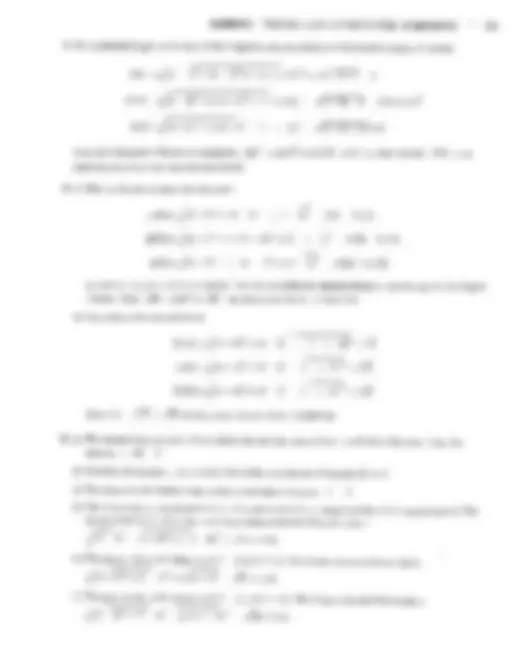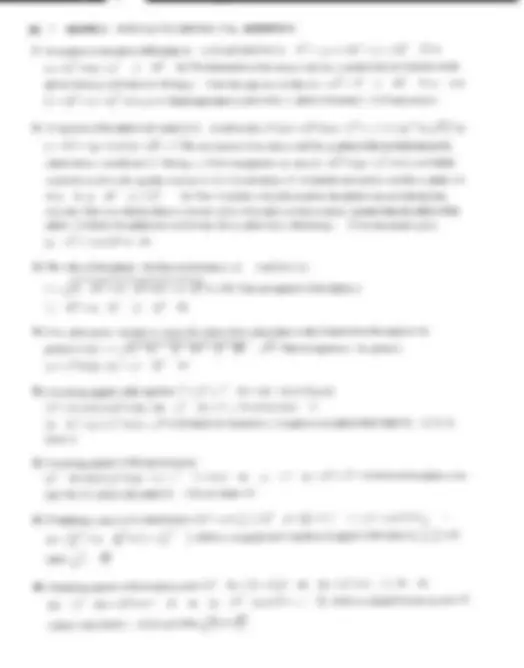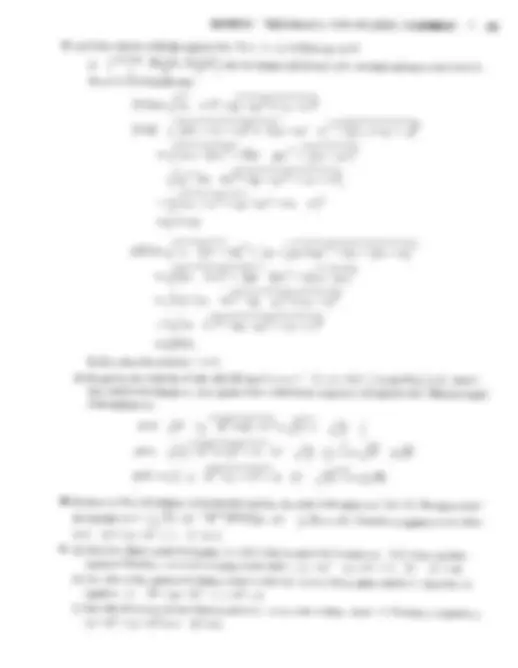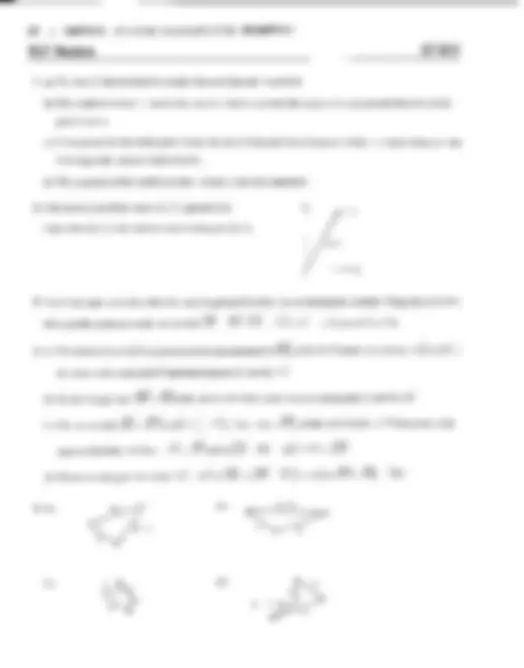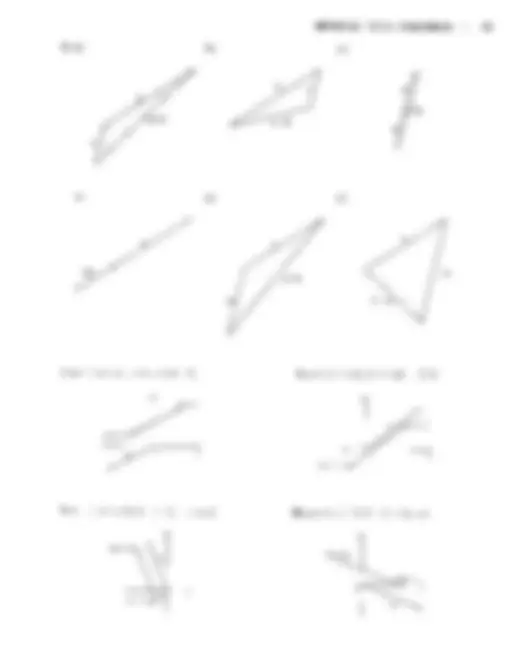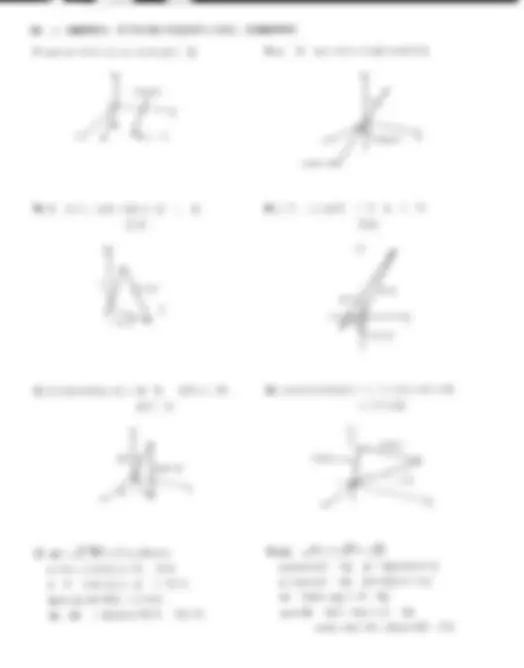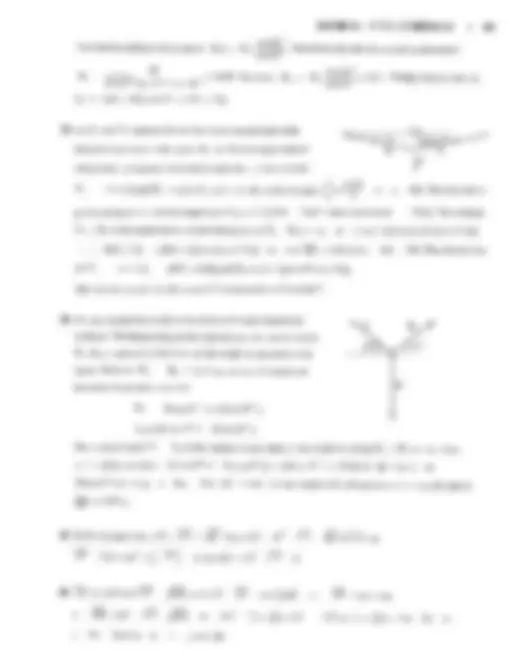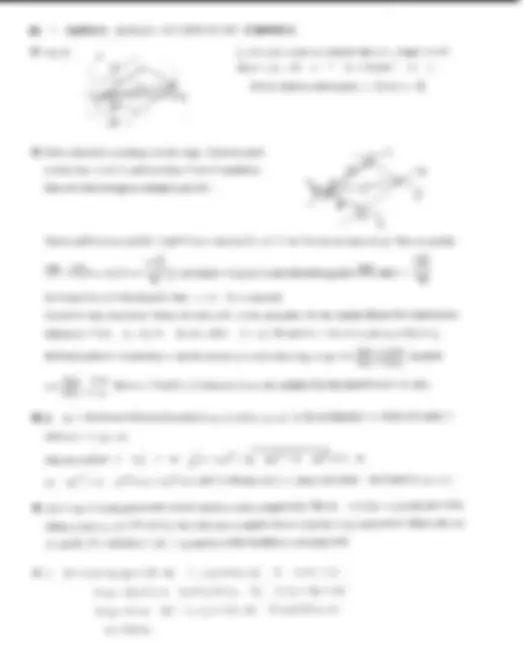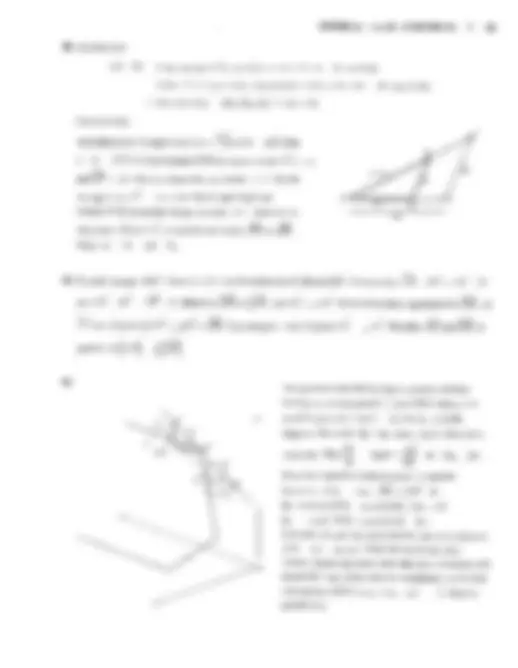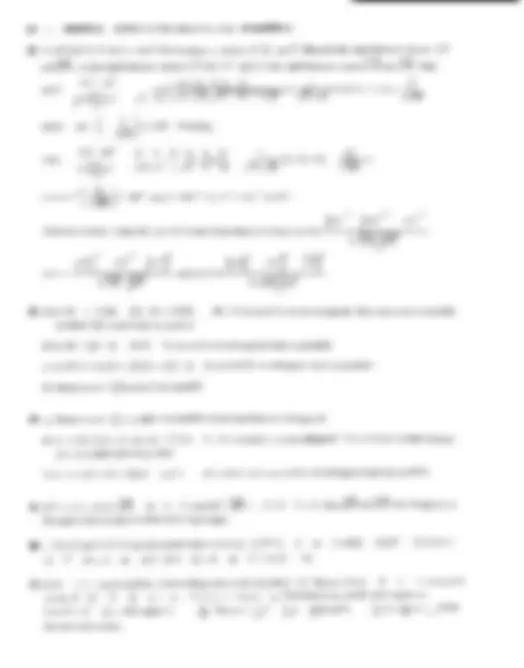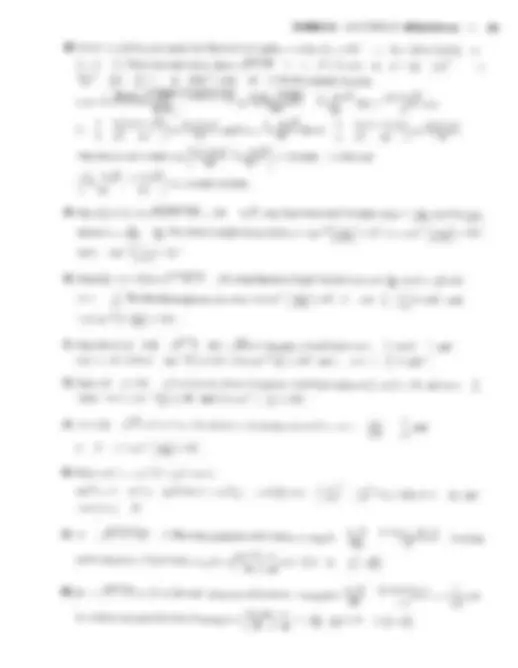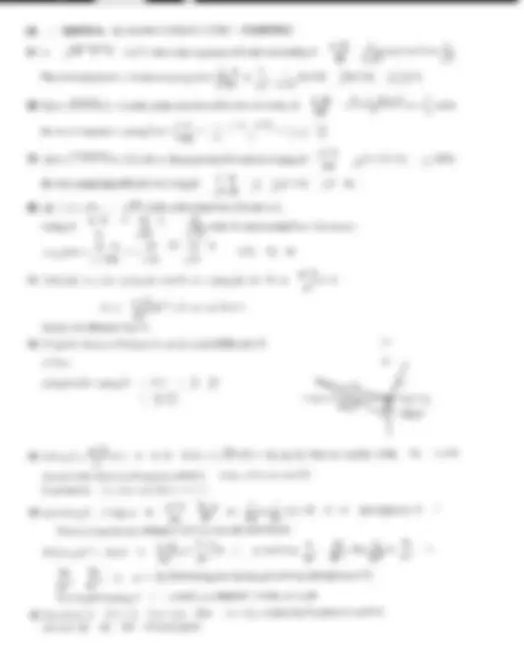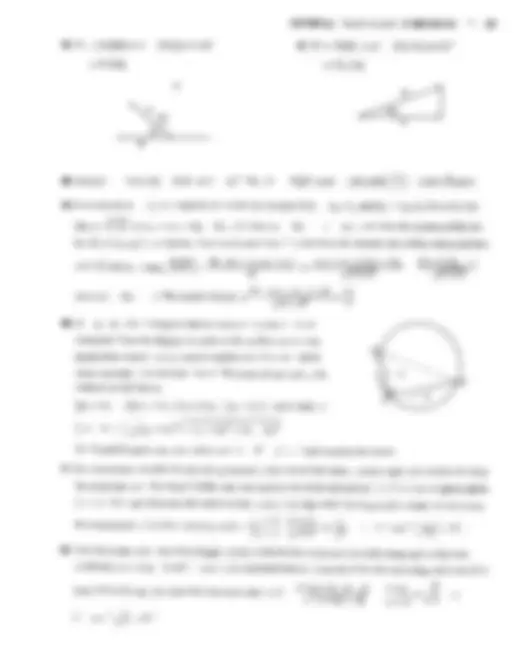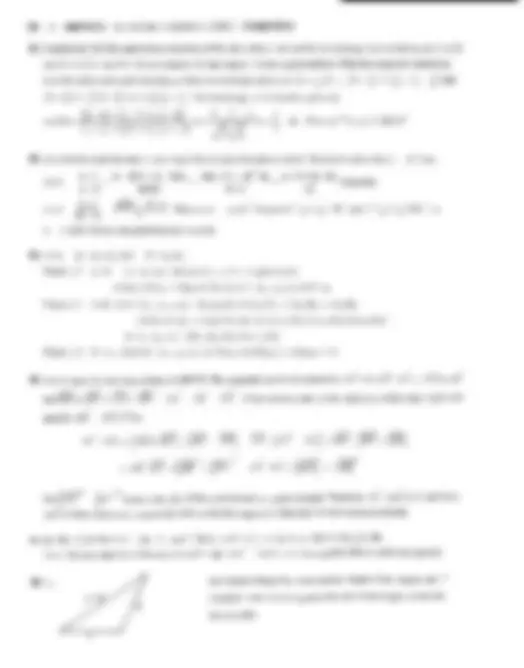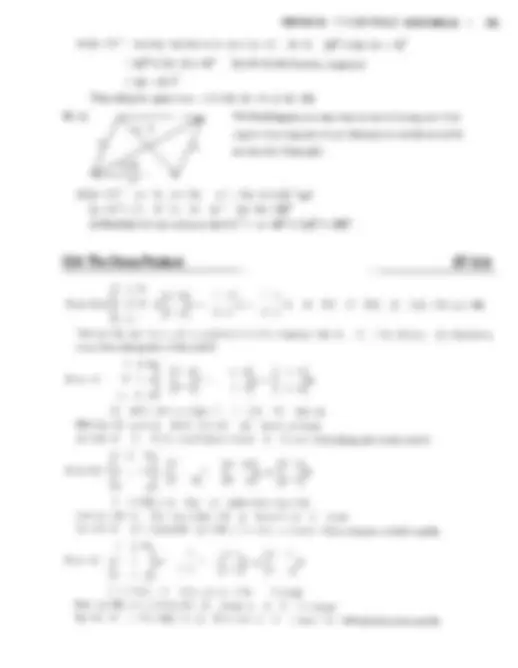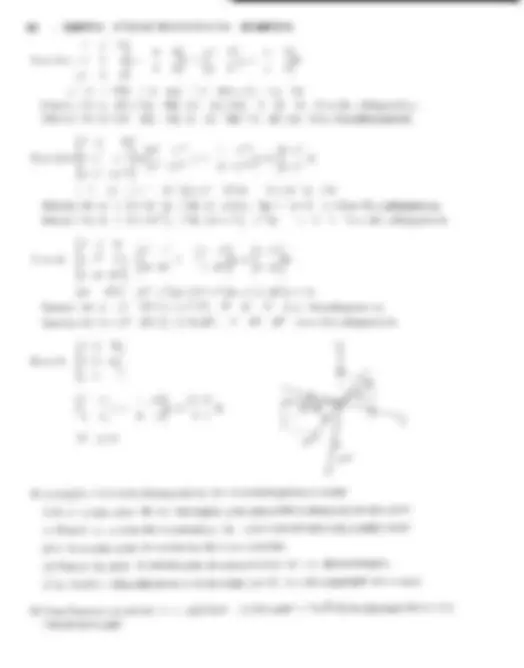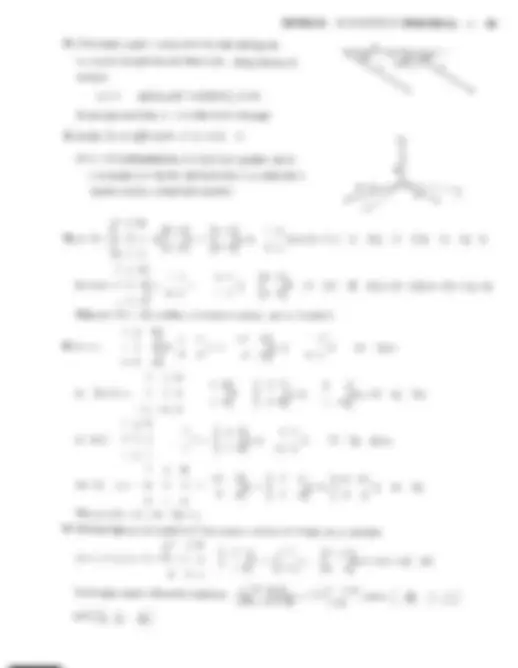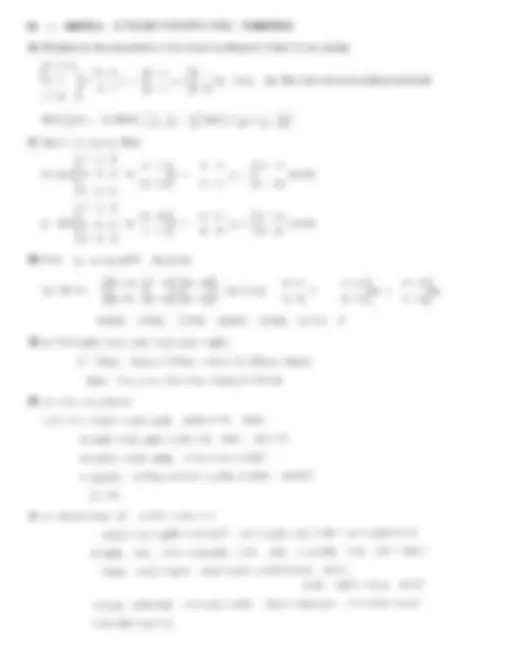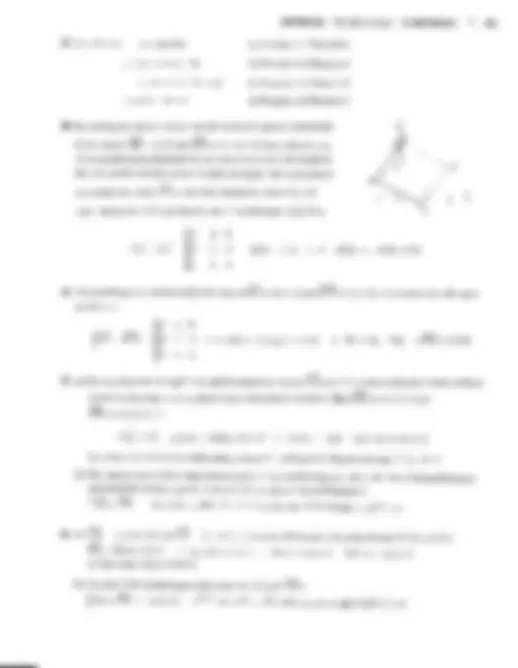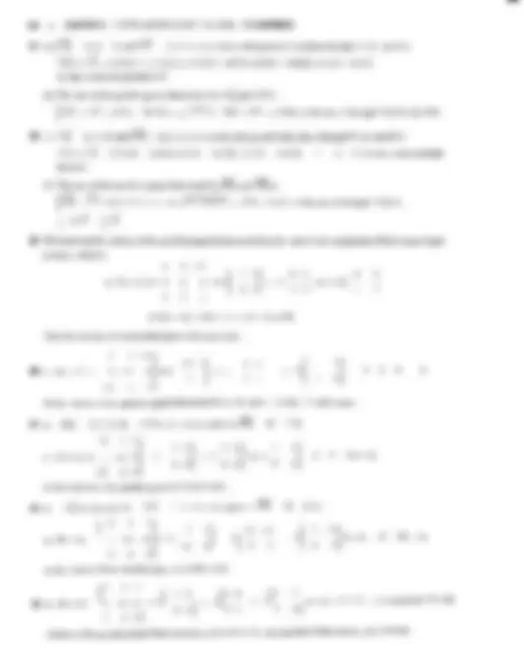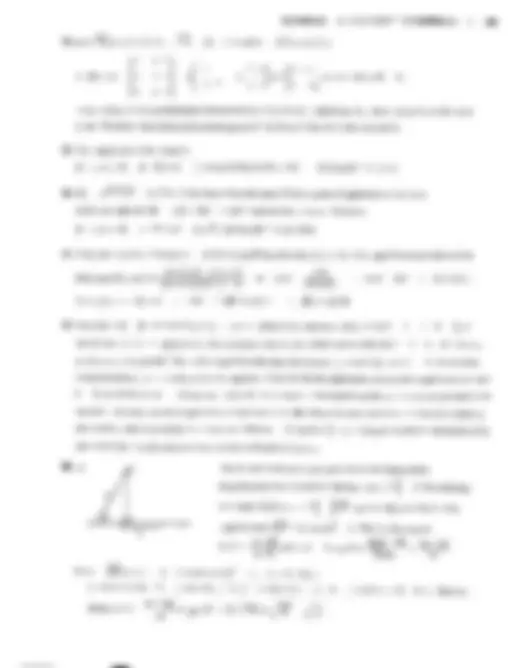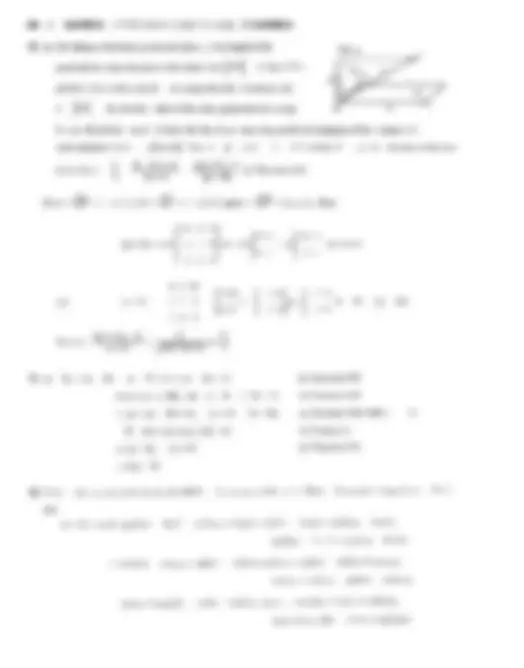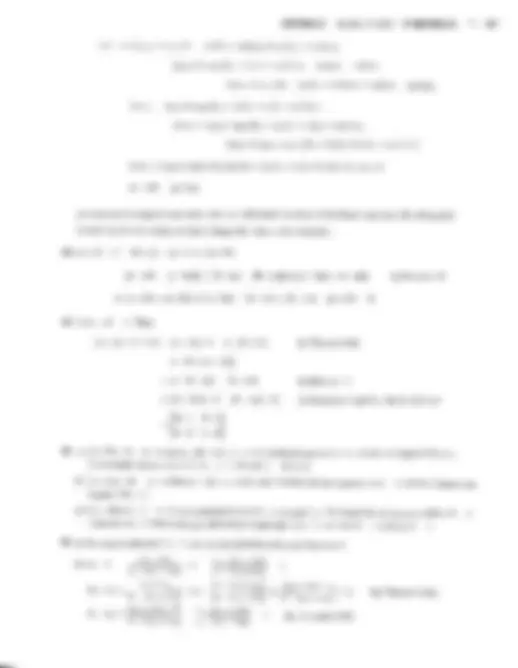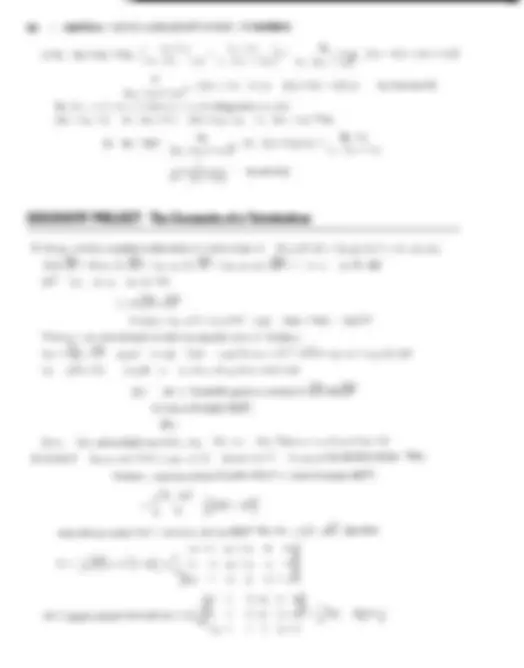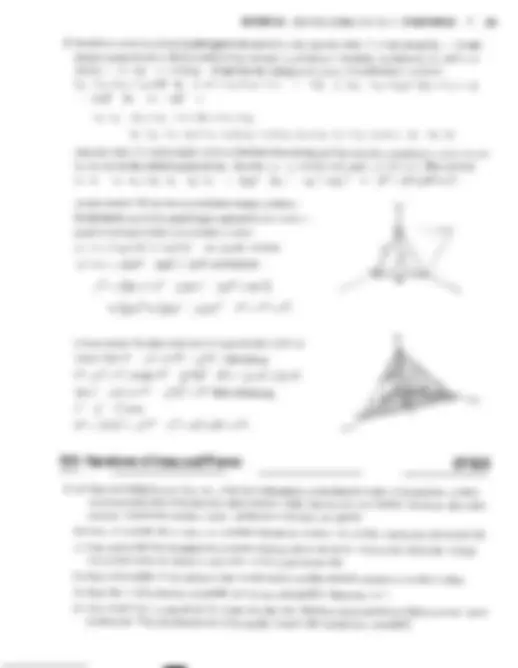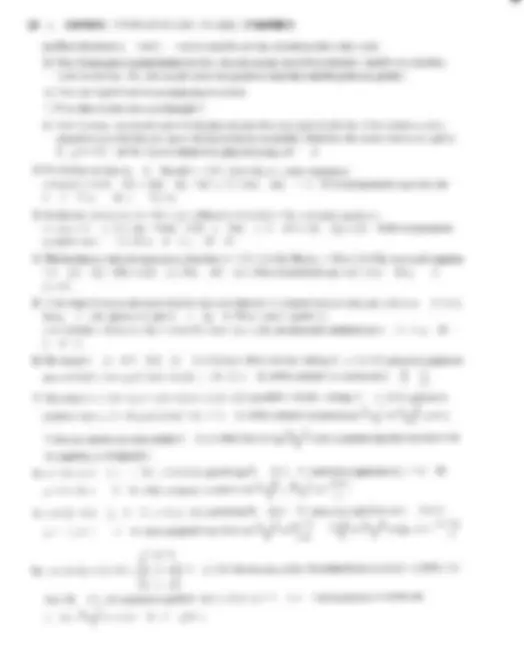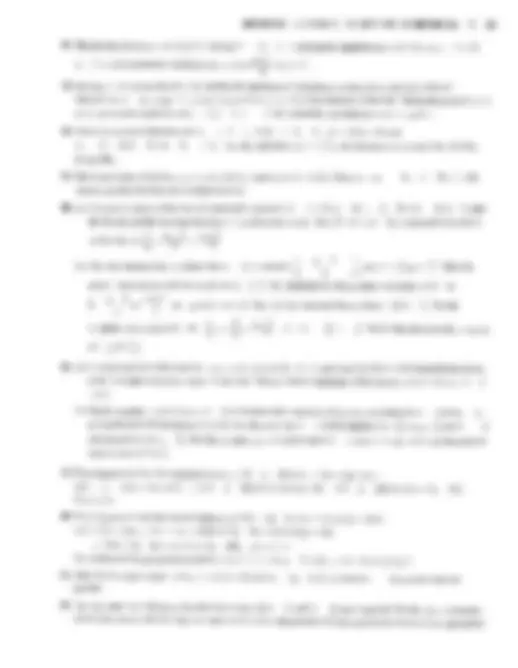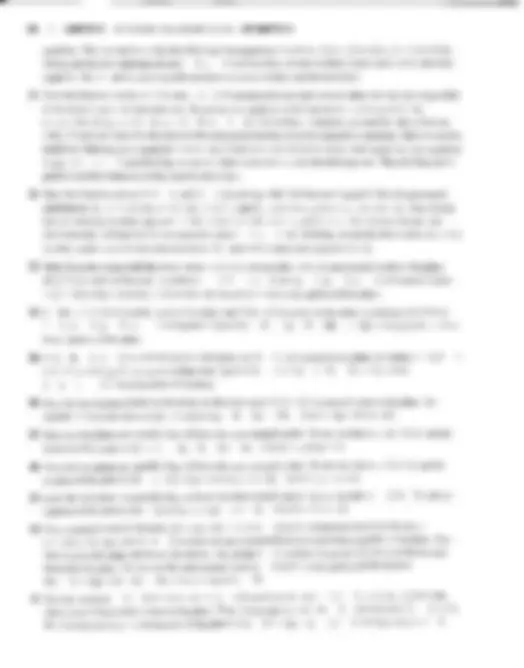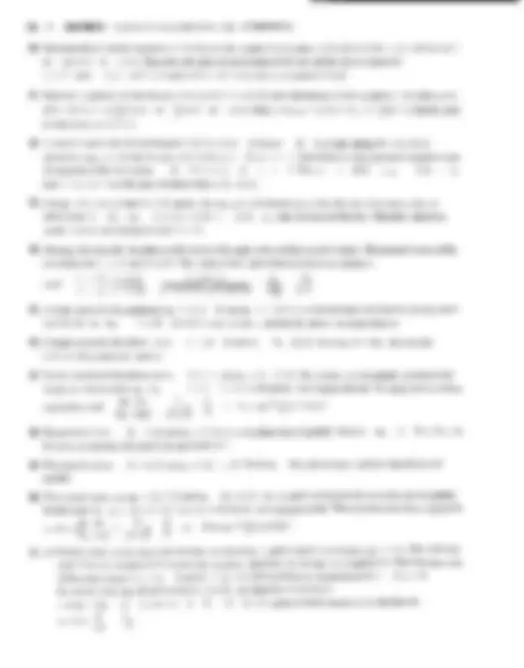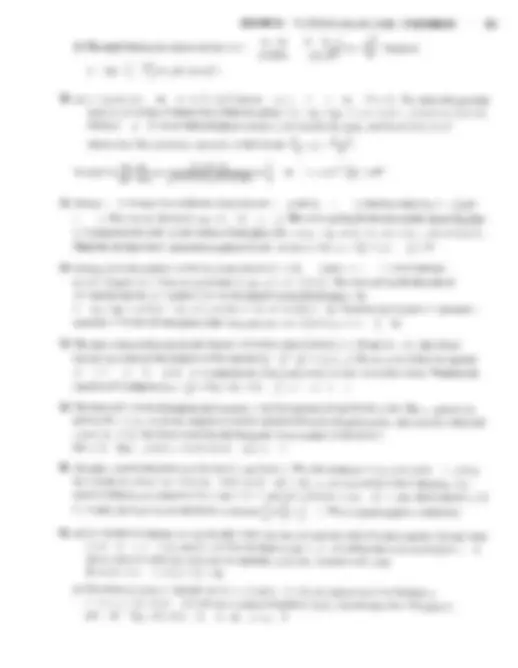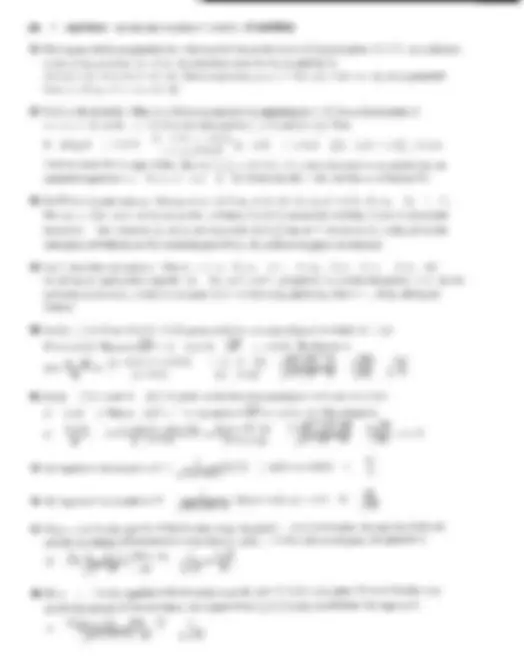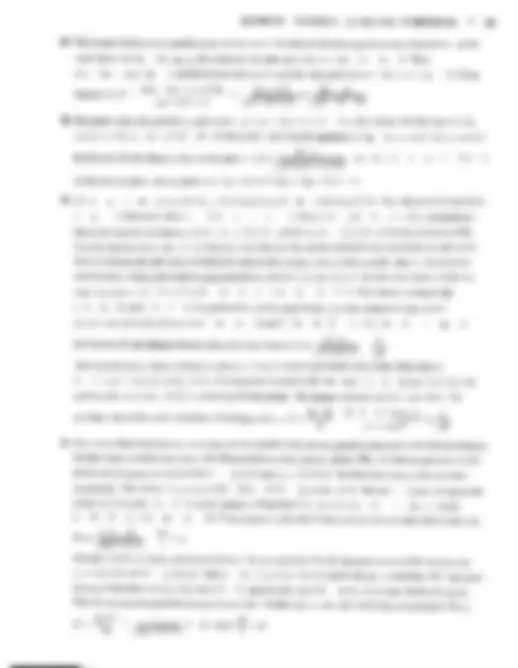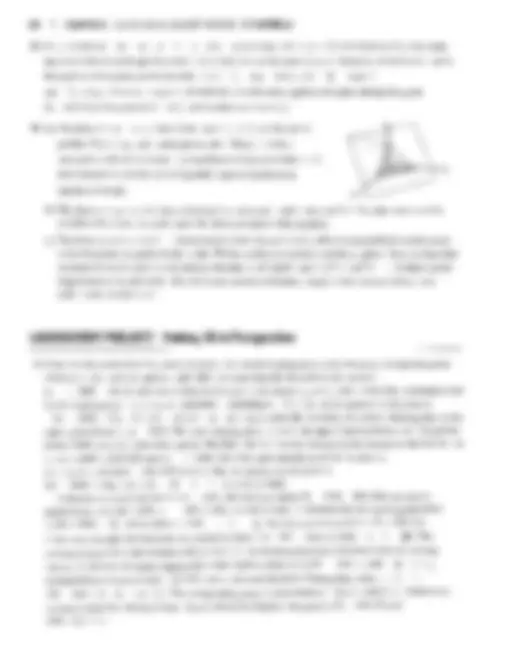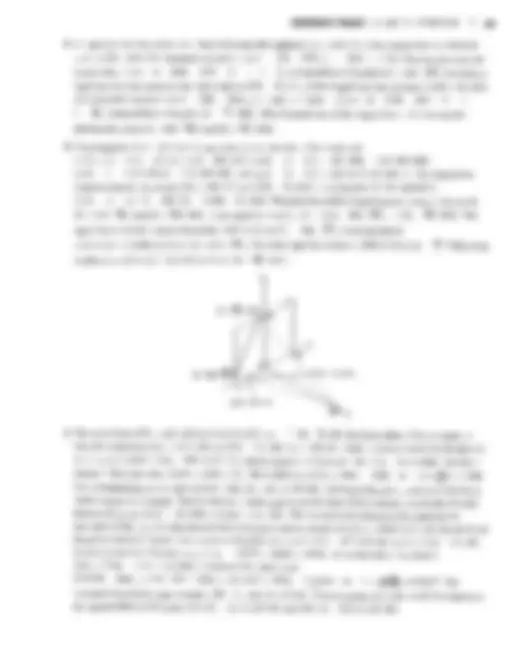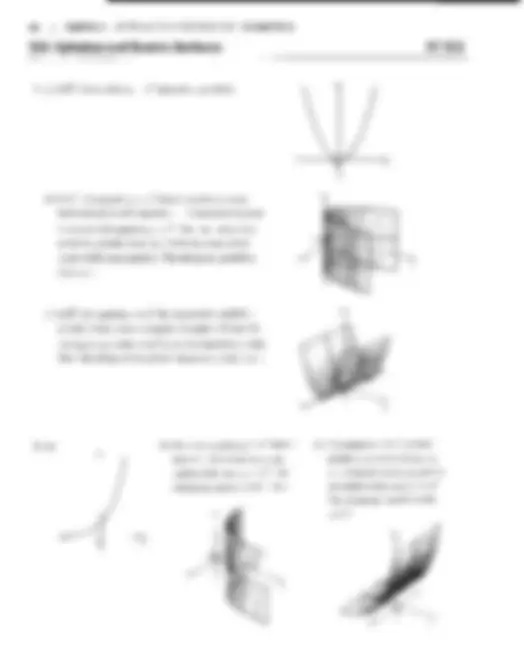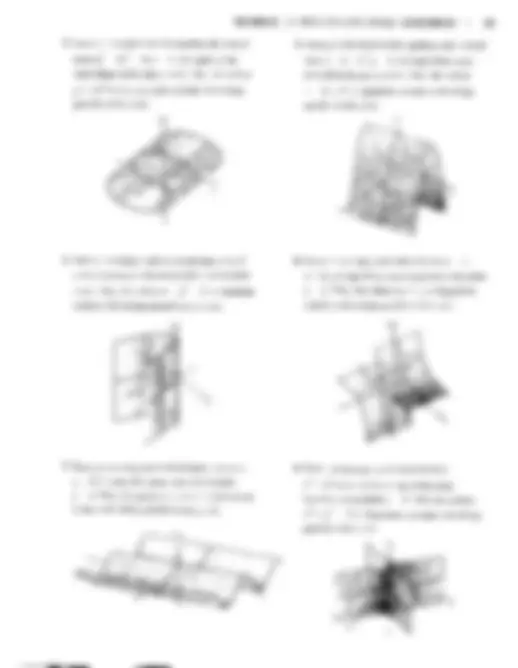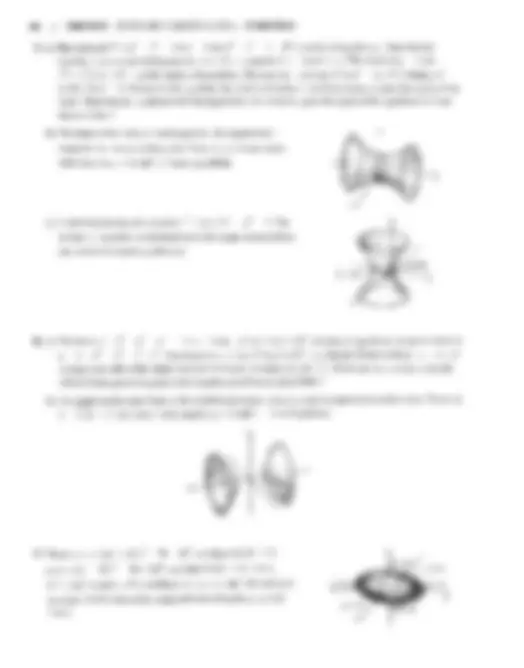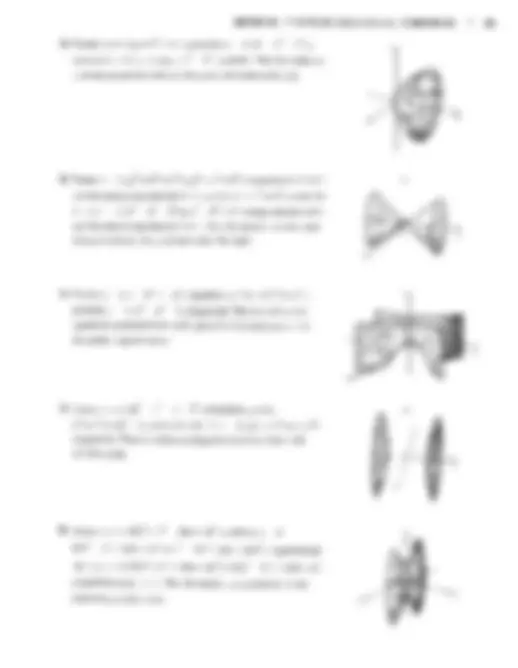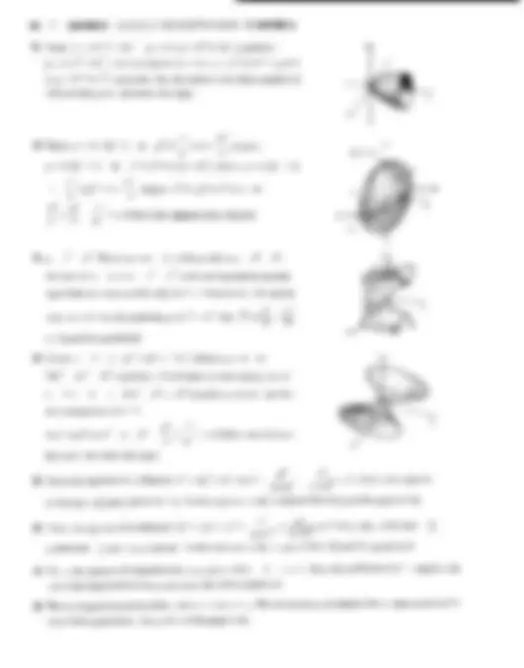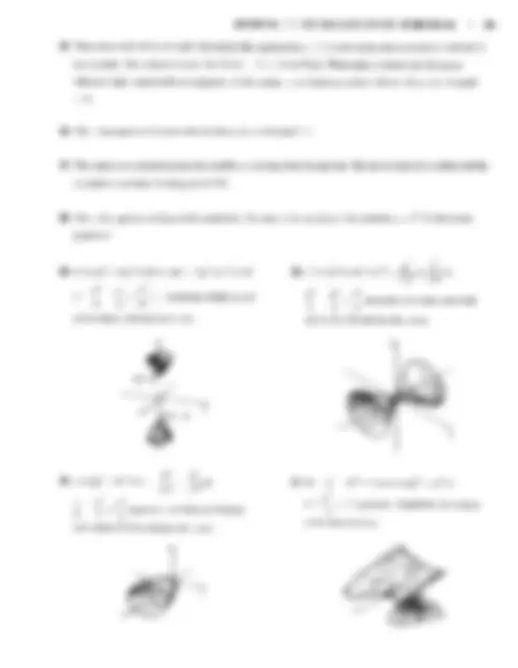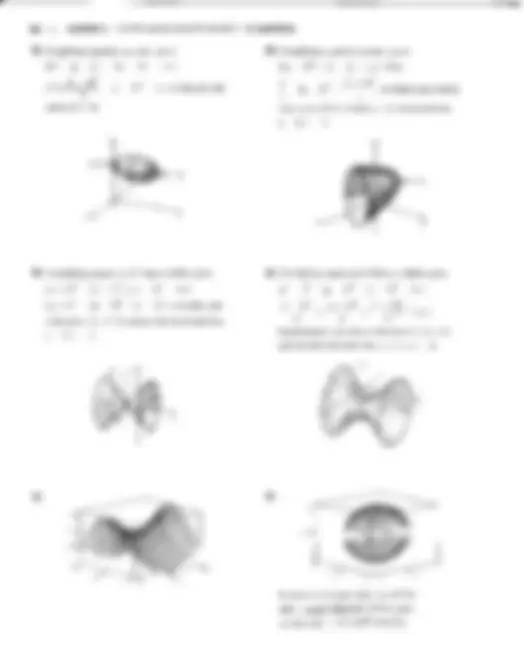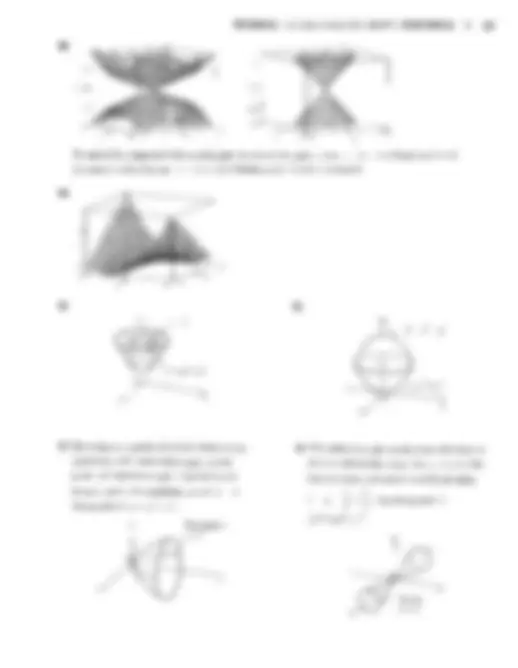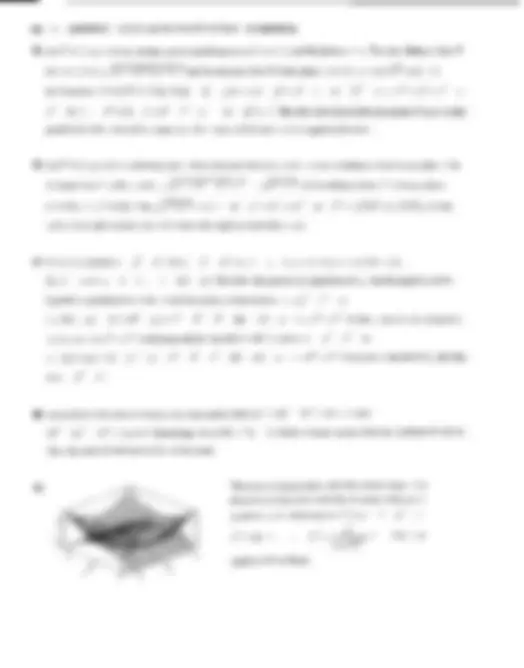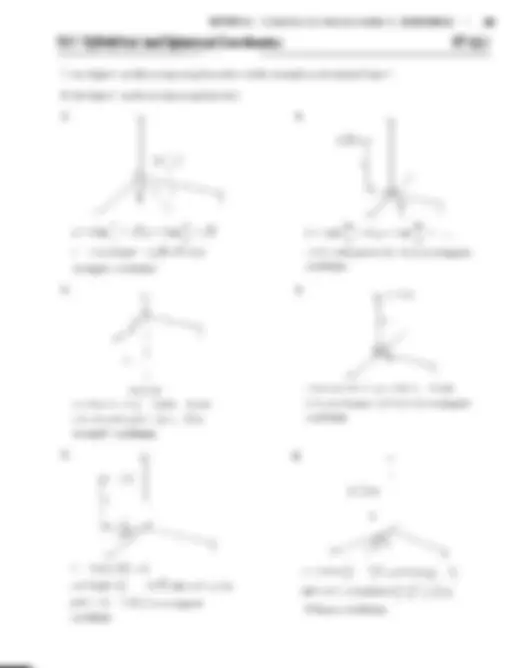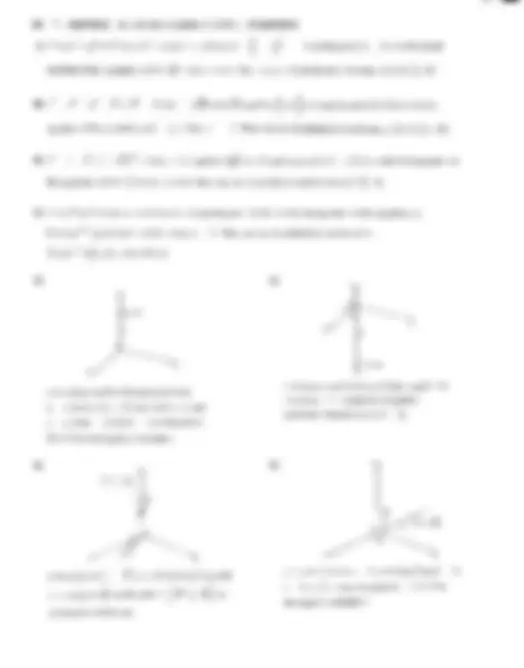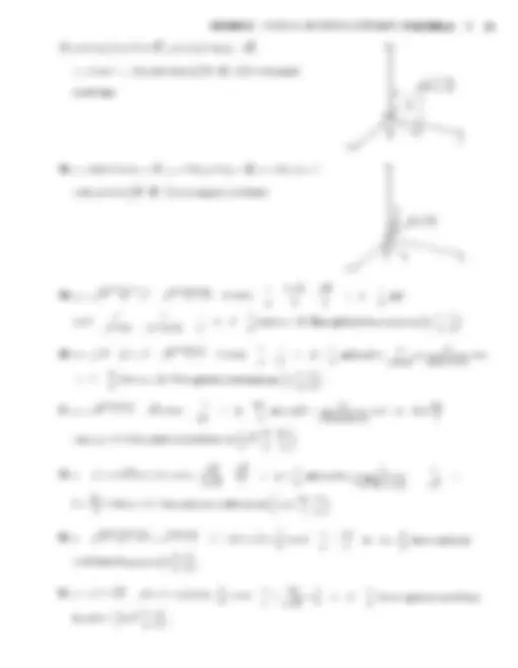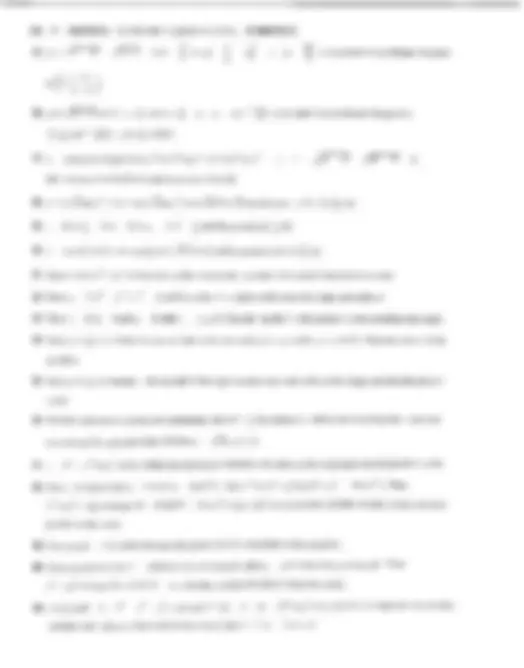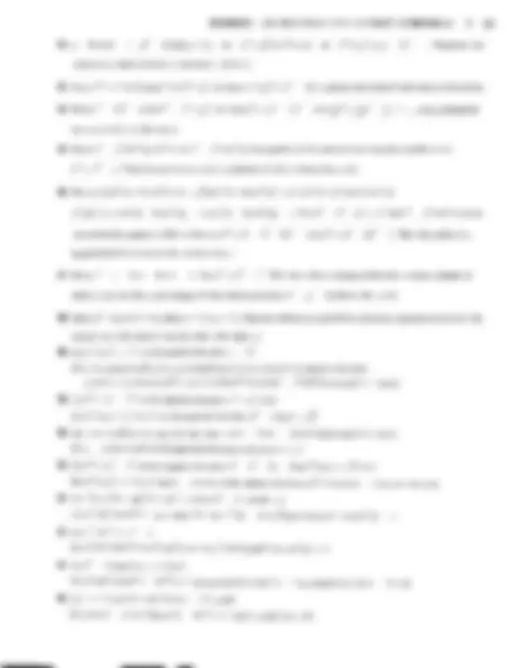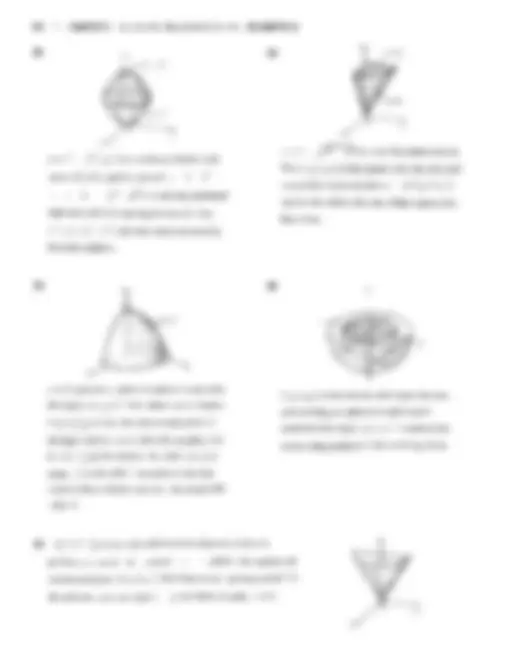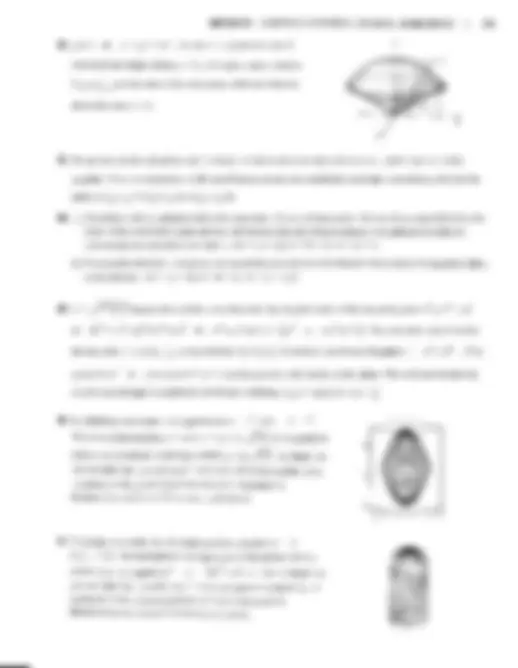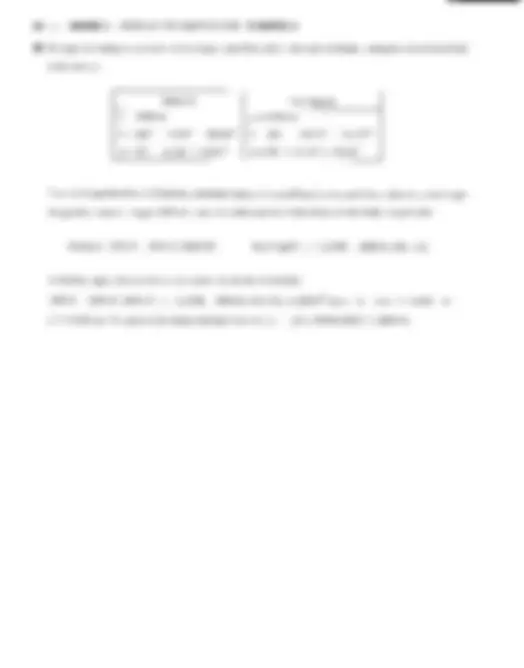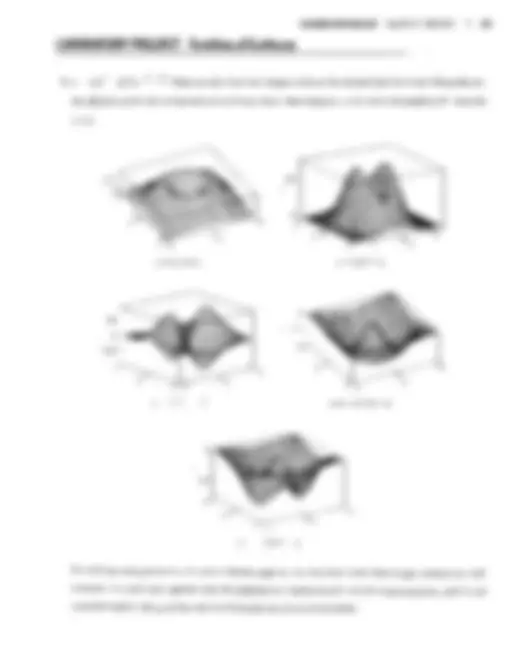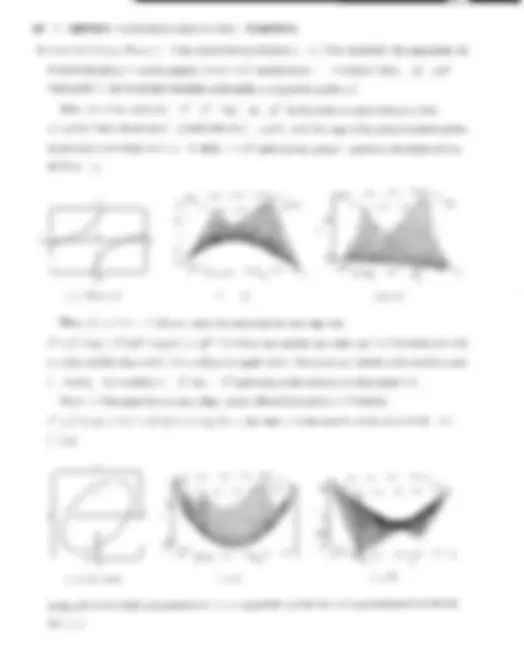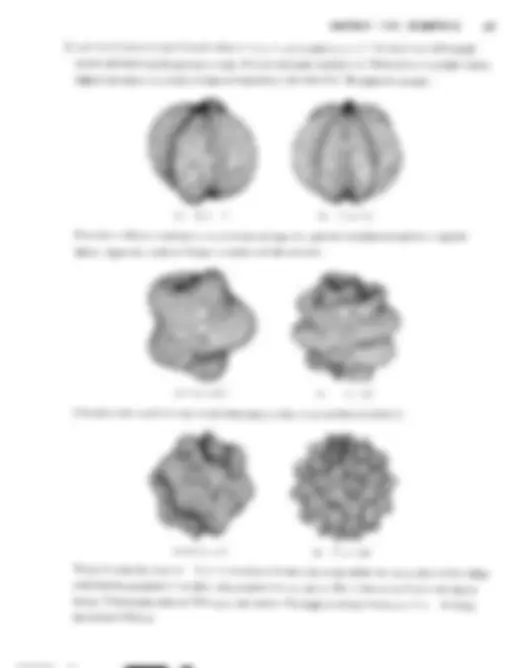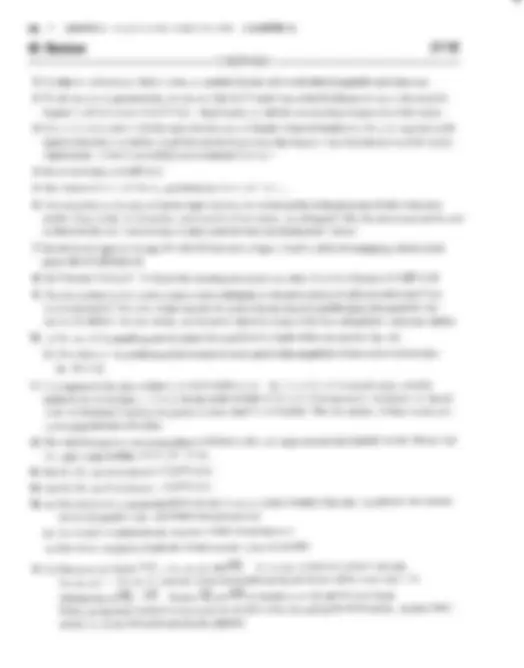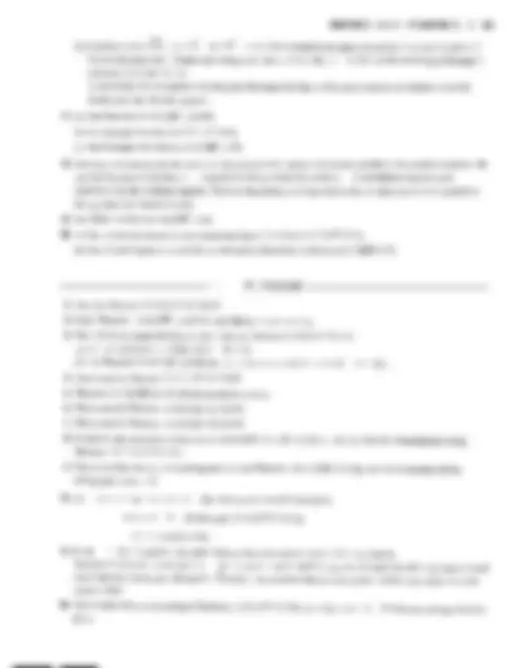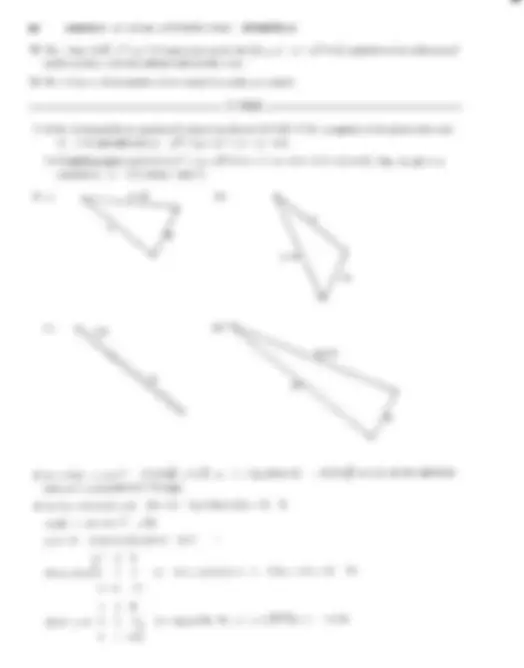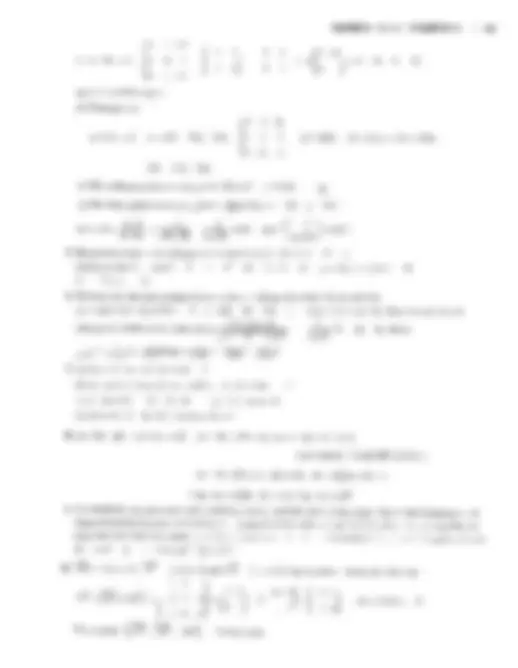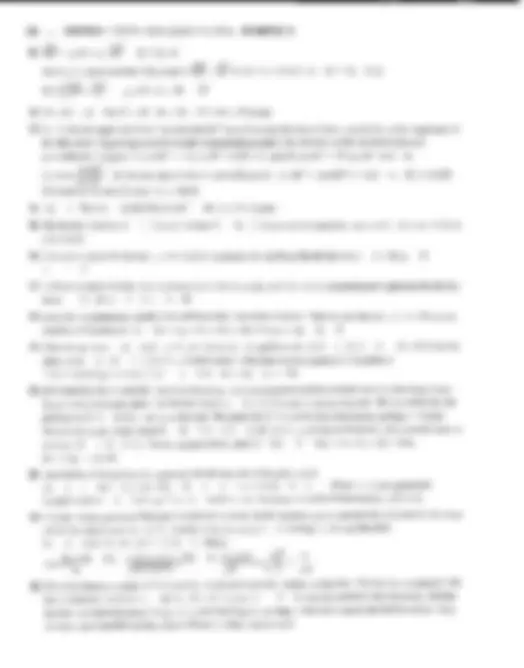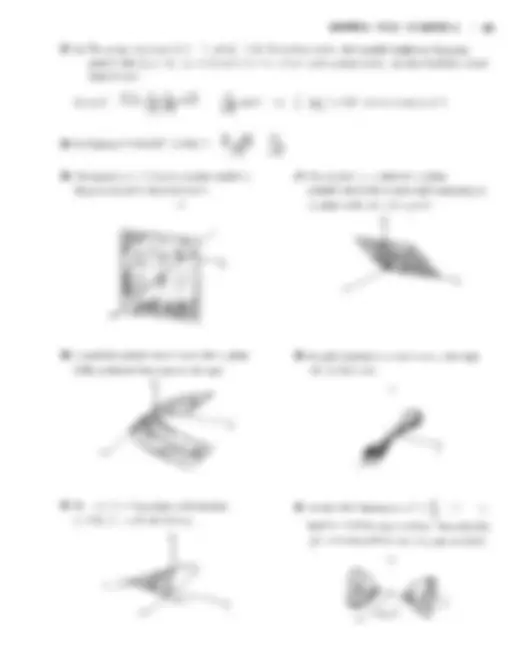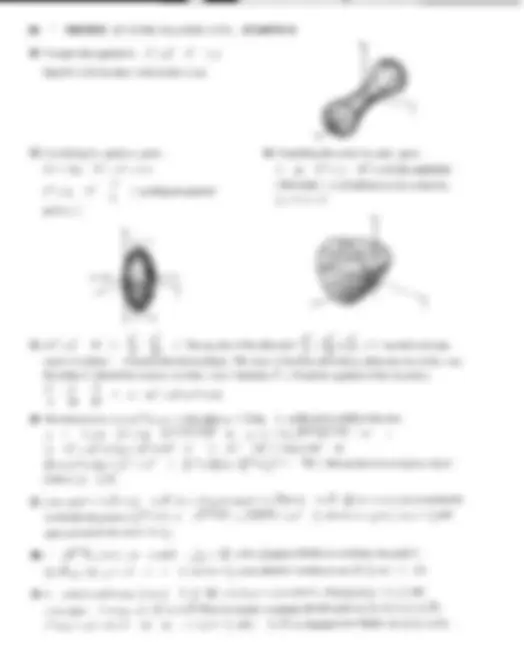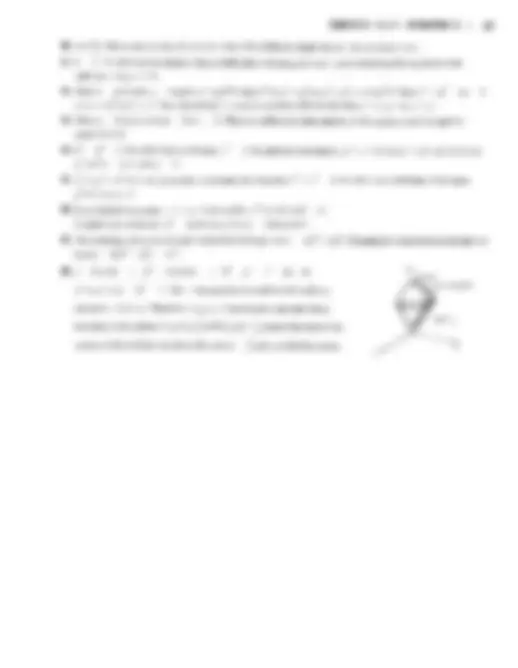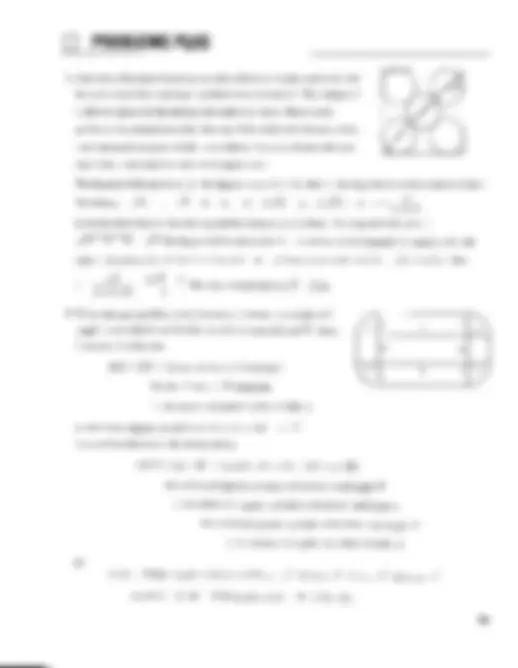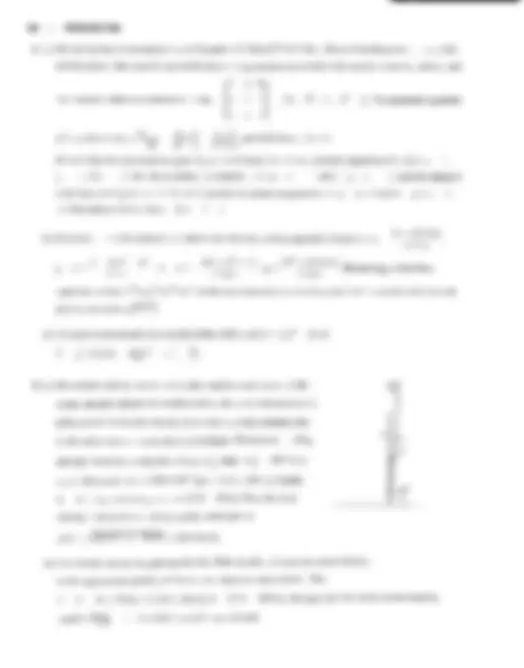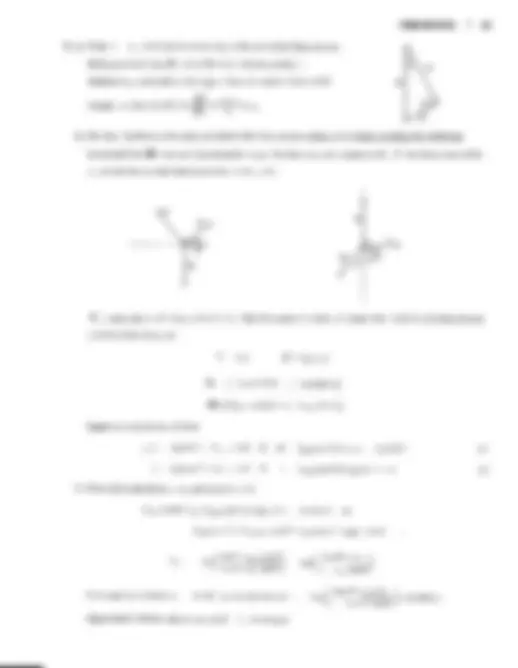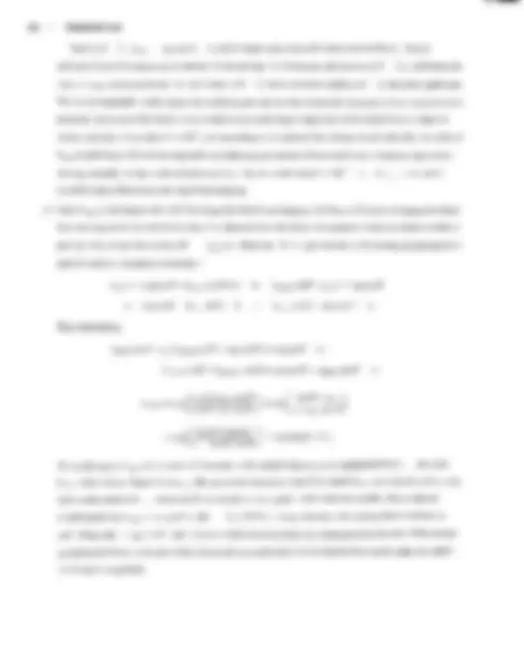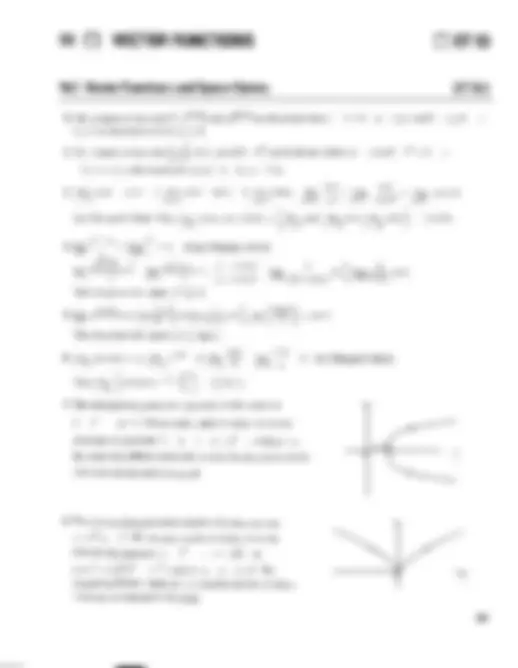Pré-visualização parcial do texto
Baixe James Stewart 5E l e ll - stewart5-14 - vol II e outras Exercícios em PDF para Engenharia Mecânica, somente na Docsity!
13 L] VECTORS AND THE GEOMETRY OF SPACE [ ET 12 13.1 Three-Dimensional Coordinate Systems ET 12.1 1 so a m . The equation x + y =: 2 represents the set of all points in We start at Lhe origin. which has coordinates (0, 0,0). 2 First we move 4 units along the positive x-axis. affecting only the x-coordinate, bringing us to the point (4,0,0). We then move 3 units straight downward, in the negative z-direction. Thus only the z-coordinate is affected, and we arrive at (4,0, —3) The distance from a point to the x:z-plane is the absolute value of the y-coordinate of the point. Q(—5, —1,4) has the y-coordinate with the smallest absolute value, so Q) is the point closest to the w2-plane. R(O, 3,8) must lie in the yz-plane sincc the distance from Rto the yz-plane, given by the a-coordinate of E, is 0. The projection of (2,3.5) on the zy-plane is (2,3, 0); on the yz-plane, (0,3, 5): on the zz-plane, (2.0.5) The length of the diagonal of the box is the distance between the origin and (2, 3,5). given by vVQ-0P+3-02F6-0P=V8a616 Rº whose «- and g-coordinates have a sum of 2, or equivalently where 3 = 2 — x, This is the set f(z2-c,z)|2E Re RJ which is a vertical plane that intersects the a:y-plane in the line y -=22=0 =" 218 — CHAPTERI3 VECTORS AND THE GEOMETAY OF SPACE ETCHAPTER 12 6. (a) In R2, the equation x = 4 represents a linc parallel to the graxis. in Rº, the equation x = 4 represents the set [(x,y.2) | x = 4), the set of all points whose x-coordinate is 4. This is the vertical plane that is parallel to the vz-plane and 4 units in front of it. (b) Tn E, the equation y = 3 represents a vertical plane that is parallel to the 2:2-plane and 3 units to the right of it. The equation z = 5 represents a horizontal plane parallel to the x:y-plane and 5 units above it. The pair of equations y = 3, z = 5 represents the set of points that are simultaneously on both planes, or in other words, the line of intersection of the planes y = 3. z = 5. This line can also be described as the set ((2,3,5) | x € RJ. «which is the set of all points in Rê whose z-coordinate may vary but whose y- and z-coordinates are fixed at 3 and 5, respectively. Thus the line is paralle) to the x-axis and intersecis the y2-plane in the point (0.3,5). 7. We first find the lengths of the sides of the triangle by using the distance formula betwcen pairs of vertices: iPol=/D-CBP+g= a +10) = v5FEri= vis = vá loRi= (1-1 +0- 224 [= (on = varia! RE A-Ha +e-0f= T+9+4= 14 Since all three sides have the same length, POR is an equilateral triangle. 20 O CHAPTERI3 VECTORS AND THE GEOMETRY OF SPACE ET CHAPTER 12 ". 12 14. 16. LIA 18. An equation of lhe sphere with center (1, —4, 3) and radius 3 is (2 - 3) +[y—(-9P + (2-3) =5 or (2-1)? 4 (y+4) + (2 — 3) = 25. The intersection of this sphere with the z2-plans is the set of points on the sphere whose 3/-coordinate is O, Putting y = O into the equation. we have (x — 1)2 +42 +(2—-3/ =25,y =0or (2-2 +(2- 3)2 9,9 = 0, which represents a circle in the 2z-ptane with center (1, 0,3) and radius 3. An equation of the sphere with center (8, 5. —2) and radius VT is (2 — 67 + (y — 52 + [e —(-2)2 — (VT) or (2-6 +(y— 5) +(z +42)? — 7, The intersection of this sphere with the :ry-plane is the set of points on the sphere whose z-coordinate is O. Putting z = O into the equation, we have (x — 6) + (y— 5)? = 3,2 = 0 which represents a circle in the ay-plane with center (6, 5,0) and radius 4/3. To find the intersection with the 2z-plane, we sety=0: (v— 62 +(2+2) = —18, Since no points satisfy this equation, the sphere does not intersect the z2-plane. (Also note that the distance from the center of the sphere to the wz-plane is greater than the radius of the sphere.) Similarly. the sphere does not intersect the yz-plane since substituting x = U into the equation gives (ye 5 + (2+2) = 29. . The radius of the sphere is the distance between (4,3,—1) and (3,8,1): (3-4 +(8-3/2+[1—(-1)P = 30. Thus, an equation of the sphere is (x-3P+(y-8P+(2-1 =30 If the sphere passes through the origin, the radius of the sphere must be the distance from the origin to the 3) re /(1-02+(2-02+(3- 02 = 14. Then an equation of the sphere is. (2-1 +(y-22+(2— 3) 14 point (1, . Completing squares in the equation «2 + y? + 2? — 6x + 4y — 22 = 11 gives (22-62 + Dr rag D +24) =114944410 (232 +(y+2)2 + (2 — 1)? = 25 which we recognize as an equation of a sphere with center (3, —2, 1) and radius 5. Completing squares in the equation gives (22 dor 04H) + =044410 + (y+1)2 42 = 5 which we recognize as an equation of a sphere with center (2, —1,0) and radius 5. Completing squares in the equation gives (22? == + D)+(P-9+D)+(2-2rg)=5+4 141 5 (a 124 (y- 4) + (2 5)? = 8 which we recognize as an equation of a sphere with center EE: radius (3 — 28, Completing squares in the equation gives 4(22 — 22 +1) + 4(y? + 4y + 4) +42 =144+16 > de P+Agp4 o ra =2 =» (2-1 +(4 +42) 42? « 21, which we recognize as an equation of = “E 2 a sphere with center (1, —2,0) and radius «/ SECTION 134 THREE-DIMENSIONAL COORDINATE SYSTEMS ETSECTIONIZA OD 2 19. (a) Tf the midpoint of the line segment from Pi(z1.31,21) 10 Pa(xo, ya, 22) is q= (nim, um, aim, then the distances |P1Q)| and [C) P$[ ate equal, and cach is half of |P: Pi. We verify that Lhis is the case; AB=y(2-n)+m-nPA(o-a) [nQl= [bles +23) =] + [Hu oo) o ]P+ [Ela tao) a]? = (ea tam )P4 (im — bu )P 4 (Emo dm)? dum) + (gen) + (2-2) IA Pal 1 2 IQPal= vía = Ari o))P A+ [yo — (gn + o) + [20 — Mas + mo]? = (es = dm) + (duo du) + (ba o da? = VP Ico —mP+ (un) + (2 —2)] avr + (gm) + (ron)? HAB] So Q is indeed the midpoint of P, Pp (b) By part (a), the midpoints of sides AB. BC and CA are P(-3,1,4), Ps(1,1,5) and Pa(2, 2,4). (Recall that a median of a triangle is a line segment from a vertex to the midpoint of the opposite side.) Then the lengths of the medians are: apl=R += cai yR440 7 EBiI= (+) +67 Qiosis E0241= 2=1vm cel= (gra nira-s= Sei vB 2 20. By Exercise 19(a). the midpoint of the diameter (and thus the center of the sphere) is C(3, 2, 7). The radius is half the diameter, sor = (41-22 +(3-1)2+ (104)? = 1 VI] = VII. Therefore an equation of the sphere is(e-3P+(y-2DP+ (2-7 =0 21. (a) Since the sphere touches the xy-plane. its tadius is the distance from its center. (2, —3, 6). to the ay-plane. namely 6. Therefore r =: 6 and an equation of the sphereis (x — 22 +(y +32 +(2-6)2=62=36. (b) The radius of this sphere is the distance from its center (2, —3, 6) to the yz-plane, which is 2. Therefore, an equationis (e — 22 + (g+32+(2- 6) =4 e) Here the radius is the distance trom the center (2. -:3, 6) to the z-plane. which is 3. Therefore, an equation is (s-22+(y+3P+(2-6P=9, SECTION 13.1 THRFE-DIMENSIONAL COORDINATE SYSTEMS ETSECTION121 DO 223 39, (a) To find the «- and y-coordinates of the point P, we project it onto Lo and project the resulting point Q onto the x- and y-axes, To find the 2-coordinate. we project £º onto either the z-plane or the yz-plane (using our knowledge of its x- or y-coordinate) and then project the resulting point onto the z-axis. (Or, we could draw a line parallel to QO from P to the 2-axis.) The coordinates of P arc (2, 1,4). (b) A is the intersection of L, and Lo. B is directly below the g-intercept of La. and O is directly above the z-intercept of La 40. Let P = (2,9.7). Then2]PBJ=|PA] & 4JPBP=|P4P é a((z-6P+(y- DP ++) = (2414 (yo 4 (e) O a(z2 122436) — —2a+a(y? dy +44) +IOy + a(o par+d) 2 s6r=35 O 3? ole + 3 Gy +32 4202 =35-144 16-16 & 22- Pery mr . . 2 By completing the square three times we ger (x — 28)? + (y - 1)? 4 (2432) —15) and radius 32 “o2, which is an equation of a sphere with center ( M. We need to find a set of points (P(x,y.2) ||AP| = |BPI|). (e+IP+Hy-5P+R-3P= VE rg TRIM SS (1+1P+(y-D+(e-3P=(0- 4-4 = 222414 -10y+25+2 6249-22-12 +36+9) -Ay44 + 4ydo+sd > 14x — 6y — 102 = 9. Thus the set of points is a plane perpendicular to the line segment joining A and B (since this plane must contain the perpendicular bisector of the line segment AB). 42, Completing the square three times in the first equation gives (x + 2)? + (y — 1)2 + (242)? = 22, a sphere with center (2,1, 2) and radius 2. The second equation is thal of a sphere with center (0,0, 0) and radius 2. The distance between the centers of the spheresis (202 +(1-024+(-2-02 = VIFIFÃ= 3 Sinceihe spheres have the same radius. the volume inside both spheres is symmetrical about the plane containing the circle of intersection of the spheres. The distance from this plane to the center of the circles is 3. So the region inside both spheres consists of two caps of spheres of heighrh = 2 — 3 = 1, From Exercise 6.2.49 [ET 6.2.49]. the volume of a cap of a sphere is Vo dmh?(3r— A) = (8 -2- 1) = tz, So the totat volume is 2. ir =. iz, 224 O] CHAPTER13 VECTORS AND THE GEOMETRY OF SPACE ET CHAPTER 12 13.2 Vectors ET 122 1. (a) The cost of a theater ticket is a scalar. because it has only magnitude. (b) The current in a river is a vector, because it has both magnitude (lhe speed of the current) and direction at any given location. (e) 1f we assume that the initial path is linear, the initial flight path from Houston to Dallas is a vector, because it has both magnitude (distance) and direction, (d) The population of the world is a scalar, because it has only magnitude. m If the initial point of the vector (4, 7) is placed at the origin, then (4, 7) is the position vector of the point (4, 7) sa , Vectors are equal when they share the same length and direction (but not necessarily location). Using the symmetry So Ss ÕiSoÕõSoÕís of the parallelogram as a guíde, we see that AB = DC. DÁ = CB. DE « EB, and EÁ=CE ES — — — . (a) The initial point of QR is positioned at the terminal point of PQ, so by the Triangle Law the sum PQ + QRis — the vector with initial point P and terminal point R, namely PR. (b) By the Triangle Law. RP + PS is the vector with initial point R and terminal point 9, namely RS. O + - (e) First we consider QS — PS as QS + (- PS). Then since —P$ has the same length as PS but points in the = “as opposite direction, we have —PS = SP and so QS — PS — QS + SP = QP. A (d) We uso the Triangle Law twice: R$ + SP + PQ = (R$ + SP) + PO RP + PQ « RG 5. (a) u db) u+y (c) v+y td) 226 O CHAPTERI3 VECTORS AND THE GEOMETRY OF SPACE ET CHAPTER 12 Na=(2-0,3-3,-1-1)=(2,0,-2) A(O,3,1 Bos -ND+( 2a) -B+(, 1+4) =(1,3) 15. (0,1,2)+(0,0,-3) = (040,1+0,2+(-3)) = (0,1.-1) UV a=/C+rP=vB=s ar+b=(-4+6,34+2) = (2.5) a-b=(-4-6,3-2)=(- 10,1) 2a = (2(-4).2(3)) = (-8,6) 3a +4b= (-12,9) + (24,8) = (12,17) WMa=(4-42 061-(-2D)=(0,2,3) AIM O,-2) (DA(S = (245.147) = (8.6) 18. (-1,0,2) 4 (0,4,0) = (=1+0,0+4.2+40) =(-1,4,2) (0,4,0) (1.02) 18. |al = 22+(-3P = 13 a+b= -3)4+(i+5j)=31+25 a-b=(i-3)-(1+5)=i-85 2m=22i-3))=4i-6j 3a+4b=3(21-3))4+4(1+55) =6i-9j+4i+20j=10i+115 18. jai 2”. z 2 2. 3, E e] =VETE+R=vD=7 a+b=(6+(-1),24+5,3+(-2) = (5.7.1) a-b=(6-(-1),2-5,3-(-2)) =(7.-3,5) 2a — (2(6),2(2),2(3)) = (12,4.6) 3a +4b = (18,6,9) + (4,20, —8) = (14,26,1) al=VETUSFTR= vê arb=(1-2;)+k)+()+2k)=i-j+3k a-b=(i-2;4k)-(j+2k)=i-3)-k 2a =Mi-2)+k)=2i- 4]+2k Jasdb=3(i-2;+4h)+4j+2k) =3i-6j4+3k+4j+8k =8i-2j+11k 1 9, —5)|= 92 +(-5)2 — 4106, sou = —== [85)|= VSEE = vil6, sou = [12i = 5jl= 1224 (-52 = 169 = 13.sou= & (12i-5j))= Bi SECTION 132 VECTORS ETSECTION122 Cl 227 2 jal= VITOR = vã —8+6,-442,-1+(-3) =(3,-2,-4) a-b=(-3 6,-4-2,-1-(-3) -9,-6,2) 2a = (2(-3),2 4). M-1)) = (-6,-8,-2) 3a -4b = (-9.-12,-3) + (24,8,—12) =(15,-4, 15) al= ERRA = VE a+b=(8i-2k)+(i-j+k)=4i-j-k a-b=(3i-2k)-(i>j+k)=2i+j-3k 2a=2(31 --2k)=6i-4k Ja+4b—8(3i-2k) 4 4(i-j +) =9i-Gk4di-4j+4k =13i-4]-2k 5 5 j The vector 8i - j — 4k has length [8i — j + 4k|= 2 + (12 +42 = VBI — 9, so by Equation 4 the unit vector with the same direction is $(8i —j + 4k)=8i-1j+4k -2,4,2]] = (22442422 = 24 = 28. so a unit vector in the direction . 1 . - vf(-2,4,2isu= 26 (-2.4,2). À vector in the same direction but with length 6 is 2v8 vê Vo vê gu=6 tram = (— 8 12.6 ) ort-v8.2.v8, VB) From the figure, we see that the «-component of v is 1 vw — Iv] cos(r/3) = 4. 1 = 2 and the y-component is Ivlsin(m/3) = 4.28 = 2.3. Thus v= (uu) = (2,28) vo ELA 3 E E SECTION 132 VECTORS ETSECTION122 O 29 cos40º From the first of these two equations [T3| = |T first of the quations [Ta] = [To] Cocsps - Substituting this into the second equation gives 49 cos 40º cos52º [Psl= = 30 N. Therefore. [Ts] = |Ts] * 38 N. Finally, from (1) and (2). º +sindoe Ts 231+30),and'T; = 231419). Let Ty and T» represent the tension vectors in each side of the clothesline as shown in the figure. TY and 'T> have equal vertical components and opposite horizontal components, so wc can write ame => a = 50b. The force due to b Ty=-aisbjamdT; =aitbi (0,b > 0) By similaririangles, — = gravity acting on the shirt has magnitude 0.89 =: (0.8)(9.8) = 7.84 N, hence we have w = —7.843. The resultant Ty + To of the tensile forces counterbalances w. so Ty + To = —w => (-ai+bj)+(ai+b))= 7.845 3.92 and a = 50h — 196. Thus the tensions => (-50birbj)+(50bi+bj)=2bj= 7.84] > p= 18 are T,=-ci+bj=-196i+3.92jandT>=ai+bj=196i+3.925. Altematively, we can find the value of and proceed as in Example 7 We can consider the weight of the chain to be concentrated at its midpoint. The forces acting on the chain then are the tension vectors Ti, 'To in each end of the chain and the weight w. as shown in the figure. We know [Ti | = |To| = 25 Nso, in terms of vertical and horizontal components. we have Ti=-25cos37"i+25sin3rºj To =25c0s37º1+25sin37ºj The resultant vector Ty + 'T of the tensions counterbalances the weight w, giving Ti + T> = —w. Since w = |wlj we have (-25cos37"1+ 25sin 37º 5) + (25cos 371425837") = |wlj > 50sin37ºj=[wlj = |wj=50sin37“ » 30,1, So the weight is 30.1 N, and since q = mg, the mass is 201 as Bol as 307 kg . By lhe Triangle Law, AB + BC = AC. Then AB + BO + CÁ = ABA CÁ tu AÓ-CÃ=20+(-AÓ) -0.soAB+ BC+TA- O. AC = 14Band BO = 25 c=DA+AO=a+ AB > AB=3e 3a. SO a c=0B+BC=-OA+;BÁ > BÃ-Sc-3b Bá=-ABsoe-Zb-3a-3e & ct2c=2a+b & c-iarib 230 ". CHAPTER13 VECTORS AND THE GEOMETRY OF SPACE ET CHAPTER 12 37. (a). (b) 3 . e (c) From the sketch, we estimate that s = 1.3 and £ = 1.6. = nd (e=sattb & 7=3s+2andl=2s-t Sulving these equations gives s = É and £ = 38. Draw a. b, and c emanating from the origin. Extend a and b to form lines 4 and B, and draw lines 4” and B' parallel to these two lines through the terminal point of c. - o Ss OB +0Q = c.soifs — (or its negative. if a points in the direction opposite OB) and é = 1 (or its negative, as in the diagram), then c = sa +tb, as required. Argument using components: Since a, b, and c all lie in the same plane, we can consider them to be vectors in two dimensions. Leta = (1,03), b — (bi. ba). ande — (c1,c3). We need say + tby = €1 and sao + tbp — ca. coa — cias Multiplying the first equation by a2 and the second by ax and subtracting, we gett = Similarly bay — bias boo —tne: e . - = E pas Since a £ O and b é O and a is not à scalar multiple of b, the denominator is not zero. bot — bjão 39. jr — ro] is lhe distance between the points (x, 3, 2) and (zo, ya, 2). SO the set of points is a sphere with radius 1 and center (xo.%0,%0) Alternate method: |r— 19,/=1 & d(z-c2+(y-wP+ie-mP=1 o (x - zo +(y — yo)? 4 (2 — 20)? = 1, which is lhe equation of a sphere with radius 1 and center (zo, yo, 20). 40. Let Pj and £; be the points with position veciors rj and rz respectively. Then jr — 11 + |r — ra] is the sum of the distances from (x, y) to Py and P>. Since this sum is constant, the set of points (1,4) represents an ethipse with foci P; and P». The condition & > |ry — ra] assures us that the elfipse is not degenerate. Mas(bre)= (m.q2) + ((br,bo) + (c),c2)) = (01,02) + (ir +e1,do + co) ( =(mrbreos+bo+e)=((m+bi)+Her(az + bo) + eo) = (tm +by.ao + bo) + (er,c2) = (401,02) + (br, 02) + (e1,02) =( a+bj+e 232 D CHAPTERI3 VECTORS AND THE GEOMETRY OF SPACE ET CHAPTER 12 13.3 The Dot Product ET 123 mn om 10. H. 12. 13. 14. . (a) a bis a scalar, and the dot produel is defined only for vectors. so (a - b) - e has no meaning () (a: b) cis a scalar multiple of a vector, so it does bave meaning. (c) Both [a] and b - c are scalars, so [al (b - c) is an ordinary product of rcal numbers, and has meaning. (d) Both a and b + c are vectors. so the dot product a - (b -H c) has meaning. (4 a-bisa scalar, but c is a vector, and so the two quantities cannot be added and this expression has no meaning. (£) lal is a scalar, and the dot product is defined onty for vectors, so Ja! - (b + €) has no meaning. =v2. Lerthe vectors be a and b. Then by Theorem 3, a -b = lal |bjcos8 = (6)(4) cos E — sr a-b=(4-1)-(3.6)=(9)(39)+(-1)(0)=6 acb= (5,4) -(-8,-3) = (5)(-8) +(4)(-3) = —16 ab= (5,0.-2)-(3,-1,10) = (5)(3) + (0)(=1) + (=2)(10) — —5 a-b= (s,28,38)-(t.+,5t) = (s)(t) + (25)(-t) + (35)(5t) = at — 2st + lôst — 14st ab=(i-2)+3k)-(5i+9k)= (1)(5) +(—2)(0) + (3)(9) = 32 ) ab=(4)-3k)-(2i +45 +61) = (0)(2) + (4)(4) + (-3)(6) = —2 Use Theorem 3: a b = [al |bfcos 8 = (12)(15) cos Z = 180.42 = 903 = 155.9 Use Theorem 3: a. b = [a! |b| cos = (4)(10) cos 120” = 40(-1) = —20 u. v, and w are all unit vectors, so the triangle is an equilateral triangle. Thus the angle between u and v is 60º and uv = ullvicos60" = (1(D)(1) = À. K-w is moved so it has the same initial point as w, we can see that the angle between them is 120º and we have u - w = |ul |w] cos 120º = (D(1)(=1) = —3. us a unit vector. so w is also a unit vector, and |v] can be determined by examining the right triangle formed by u and v. Since the angle between u and v is 45º, we have |v| = [ul cos45º = *2. Then u-v= jul [vlcos4s? = (1)(22) 42 = 1. Since w and w are onthogonal. u- w = 0. (ai) = (1,0,0)- (0,1,0) = ((0) + (0)(1) + (060) = O, Similarly j - Je = (0)(0) + (1)(0) + (0)(1) = O and ki = (0)(1) + (00) + (1)(0) = 0 Another method: Because à, j, and k are mutually perpendicular, the cosine factor in each dot product (see Theorem 3) is cos 5 — O, = 1 since À is a unit vector. Similarly. j -j = |]? = Land (b) By Property 1 of the dot product, à + = [il kk k2=1, The dor product A - Pis (0,9,0)-(2,1.5,1) = a(2) + KL5) + e(1) = (number of hamburgers sold)(price per hamburger) + (number of hot dogs sold) (price per hot dog) = (number of soft drinks sold)(price per soft drink) so it is equal to the vendor's total revenve for that day. SECTION 133 THEDOT PRODUCT ETSECTIONIZ3 DO 23 15. al= VP +42 5. |b|= 52 +12 = 13.anda-b = (8)(5) + (4)(12) = 63. Using Corollary 6, we have ab 63 63 ss so= DD 8 gomes and bis O — cos (8) = 14º. cosg Tarfo] É 5.13 = 65" 5º the angle between a and bis O — cos (E) =14 V (V3P=2=2,|bj=V0FB-Sanda-b= (3)(0) + (1)(5) = 5. Using Corollary 6, we have abo 5 1 . a eo Ab 2572 and the angle between a and b is cos"! (1) = 60 cosd — Nal=v2+2+2- vi b|=/2+0+(-12- VIT anda-b= (1)(49)+ (2)(0)+ (8M-1)= 1 = ab — 1 — 1 n co— —1 1 2 BG? Then cos 8 = ET] ATE VER MM the angle between a and bris 6 = cos (3) 86º. 18. lal= (2103272 =7. l= = 2 FR+4(2P=3anda-b= (0)(2)+(-3(1) + (2-2)= 5. a-b 5 59 = = andê=cos (E)m to. Tencoo = = ndo = cos (6) me 76; 19. ja =VP+PIP = va lb|= VITRREACIR = vd am ab (00) + (06) + (UK) = = ab -1 q 1 ) o Thencosf= —— === and8 = ——= | = 101º. ec = Tg = EA O DA “E ( 2v7 2” lal= /2- CIP += vB b= +24 (C1? = vid. and ab 3 3 -b= (23 —D() + 1)=3. Thencosd= —— — —== and a (8) + (DO) + UND) FBI = VE vã VE 3 8= cos | na) co (5 21. Leta, b, and e be the angles at vertices A. B, and € respectively. Then a is the angle between vectors AB and AC, b is the angle us BÁ BC berween vectors 34 and BC. and e is the angle between vectors CâuaCi RA Dae AB.AC e (24) 1 2 vã Thus cosa = LEÃO 16) (dy - A+) = =” [48] ad] DIV IA vao >= qm Da anda = (2) = 45º. Similarly. + BA-BC (-2.-6) (-4,--2) 1 20 v2 cosb = DA = = 8+12)= = [à Ed +36 16 +4 va vã! ) vm 2º Al b=cos (2) =45ande= 180º (45º+45º)=807 El - [az - zof Altemate solution: Apply the Law of Cosines three times as follows: cosa = Pa E pop - and cosc — apela 28. 28. 30. 3 32. E 3». 3. . Since [214 3; - 6k|= 1036 = 49 = 7. Equations 8 and 9 give cosa SECTION 133 THEDOTPRODUCT ETSECTIONIZI3 O 235 Letu - (a,6) be a unit vector. By Theorem 3 we need u -v = Jul jv!cos60º & Ja+4b=(D(5)) + ja. Sinceuisaunit vector. ju = VZ FP =1 6 a2pb=1 4 ads(E-ta))-1 é —-Bor=1 e 1000? — 604 — 39 = 0, By the quadratic formula. da (60) + (00 AGO) c0+VINNO 3+4V5,( 3743, 2(100) “0 “10 “= "10 af8rav3) 4 3vB, 3-4v3 5 3/3-4V3) 4+3v3 -5 andifa — thend= 2 — 2[2oóviA ttive alo 10 10 s 4110 10 3+4v3 4-3V3 Thus the two unit vectors are (EE (ER, 4- ad TR E) 4 (0.9928, —0.1196) and 96 10 10 —0.3928, 0.9196). Since (3, 4,5)| = 016 +25 = 50 = 52. using Equations 8 and 9 we have cosa = and cos = 5Sy = z. The direction angles are given by x = cos”! (5) n65º.8= a t( Since [(1,-2,—1)!= VT +41 = v6. using Equations 8 and 9 we have cosa = and 45º cosy = 5. The direction angles are given by ex = cos”? (E) a 66º,8 = cos] q= cos t(-1) a 4º cosy= 2 whilea = cos !(2) =: 73º,8=cos-!(2) =: 65º, and = cost! ( Since [21 — j + 2k] = 47F1 +44 = 9 = 3. Equations 8 and 9 give cosa = 2 while a = «= cos”! (3) a 48º and = cosTt(.-1) = 109º Keco|-/2F3+E = v3e (since e > 0), s0 cosa = cos 8 = cosy a=8 =7=csi() = 55º Since cos? a + cos? 6 + cos? y = 1, costy=1-coZa-cosB=1- cos?(7) — cos2(E) = =1 “= = 1 Thuscosy = +! and v=Foy=%. lal = 4/37+15477 = 5. The stalar projection of b onto a is comp, b = AP — dbntéo = 3 and the a vector projection of b onto a is proja b = (52) lado la] = 4/12/22 = 4/5. so the scalar projection of b onto a is comp, b = - a-b) a the vecror projectionol bontcaisprojb= (22) 2 =. 2.1 Pres al / ja VE 26 O CHAPTERI3 VECTORS AND THE GEOMETRY UF SPACE ET CHAPTER 12 —— 3 37. lal = 16-10 = 2,5 so the scalar projection of b onto a is comp, b = = 4+2+0 proj Pp, ai Edi )= NA 3a The vector projection ol bonto ais proj,b : =— (4,20) 5(6.8,0)= v5lal” vô Ed é + 38. !al= 1454 — 3 so the sealar projection of b onto a is compa b — = = cerco =. while the vec iecti bo MN AA-2D 122 e vector projection is proj, b = 33 /& (5) = a 39 Jaj= 3 while la the vector projection of b onto a is proj,b= —=— = v2 al 4. | v4+9+1 — 14, so the scalar projection ot b onto a is bo 2-18- 1 , o comp, b = Alb — 271852 18 pipe the vector projection of b onto ais lal 14 V 18 a 18 2i-3jrk iojab=-—D 2... AOTL 9; -3)+k Peba Va qi tcH+H M. (orthab)-a— (b- projb)-a=b-a- (projab) a=b-a- -a =b 1 RE 7 laf =b.a-a-b=0 So they are orthogonal by (7). 42. Using the formula in Exercise 41 and the result of Exercise 36, we have orthab=b projjb=(-41)-( 2.5) =(38.8) 43. comp,b= a n -=2 é ab=2]al=2VT0.]fb- (bi.ba, bs). then we need 3, + Oba — lba = 210 One possible solution is obtained by taking by = 0.62 = 0,65 = 210. In general. b = (5 —2v10).s.tER. ab ba 1 4, (3) comp, b= compra é» ur = o us That is, if a and b are orthogonal or if they have the same length b. (b) proj, b = projpa & a= É > 1 RE ez = Jal = [b). Substituting this into the previous equation gives a = b. al i Soprojb =projya «> aandb are orthogonal, or they are equal. 45. Here D = (4 2)i+ (9 3)j + (15--0)k = 21+ 6) + 15) so by Equation 12 we have =F-D=20+ 08-90 = 38 joules 
